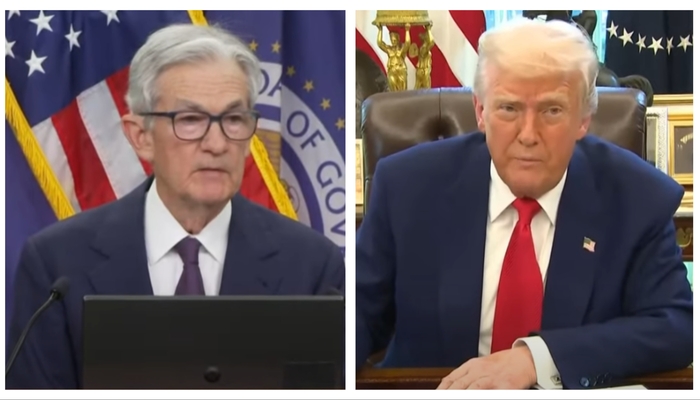


Here’s a rule of thumb: Anybody who thinks that the Federal Reserve isn’t innately a political entity should have his head examined. But the collective of prefrontal cortex-challenged geniuses on The Washington Post editorial board are acting as if this politicization only started when President Donald Trump started putting pressure on Chairman Jerome Powell to lower interest rates.
This gives new meaning to the term “headcase.”
The Post’s July 15 editorial was about as clear an attempt to drum up cheap scare porn as it gets. “Trump’s attacks on the Fed are worse than you think,” the editorial board cried. With Trump, it's always "worse than you think."
“Politicizing the Federal Reserve could unmoor inflation expectations and drive up borrowing costs.” “Unmoor inflation?” Really? And who exactly does the newspaper think was largely responsible for unmooring the 40-year high inflation crisis by arbitrarily overloading the money supply in the first place?
Despite Powell’s already sordid record on monetary policy, The Post had the gall to treat the Fed chairman’s expertise as being mutually exclusive from trigger-happy politicians desperate for some kind of economic win: “Politicians aren’t good at monetary policy. They face a powerful temptation to goose the economy in the short term, even at the cost of future growth.” How is it possible to write this in retrospect with a straight face? “Goos[ing]” the economy off-the-rails is exactly what Powell did during the first half of the Biden administration that contributed to sending consumer and wholesale prices to the moon.
Oh but for The Post, it is Trump that is “eroding” the “critical national asset” of the Fed’s make-believe “political independence” in “ways that could be bad for the country and his own agenda.”
In its imaginary world, The Post argued that it is of utmost importance to protect the sense that the “world’s most powerful central bank makes decisions based on economic conditions, not short-term political considerations.” Were the editorial board members drunk when they drafted this? As investment banker and two-time New York Times best-selling author Carol Roth quipped in a July 21 X post, “The Fed works exactly as it was intended, to support those in ‘the club’ at everyone else’s expense.”
This apparently was lost on The Post, which based its argument largely on the “unlikely” prospect that Trump will either fire Powell or so politicize his position that his successor will inevitably be viewed by the markets as partisan and the economic screws will come loose. “[I]mmediate disaster might result: Investors might lose confidence in the Fed’s ability to make politically tough but economically necessary decisions. Investors might abandon U.S. assets, bond markets might go haywire, and the dollar might plummet.”
In essence: The end of the world is nigh!
The Post’s rant blatantly obscures the historical facts — there’s a surprise. The Fed being driven by politics is engrained within its modus operandi. Economist Charles Weise published a 2012 paper in the American Economic Journal concluding that “political pressures on the Federal Reserve were an important contributor to the rise in inflation in the United States in the 1970s.” Specifically, wrote Weise, “Political considerations contributed to delays in monetary tightening, insufficiently aggressive anti-inflation policies, and the premature abandonment of attempts at disinflation.” Is it so far-fetched then to believe that Powell — who’s paraded himself around as a neutral referee devoid of bias — is purposely balking at cutting interest rates despite the Fed’s preferred inflation gauge being just shy of the two percent target gold standard (2.3 percent in May) for political reasons? Maybe, maybe not.
Economist Brian Wesbury was adamant during a July 17 appearance on Fox Business’s Varney & Company that it is a “myth that [the Fed] has been independent.”
Wesbury told host Stuart Varney that “today’s problems for the Fed — Trump going after them — they caused. Because back in 2008 with Ben Bernanke and quantitative easing, the Federal Reserve became un-independent. They started government spending with quantitative easing.” After making the poignant observation that the Fed and Treasury Department have since become virtually indistinguishable from each other, Wesbury asserted that Trump “is absolutely right. Inflation’s low, they should be cutting rates. “Then came the kicker: “Powell did [cut rates] before the election. To me, that was political — a political rate cut before the election. And now he won’t, and I think a lot of this has to do with politics.”
Egads! Could it be true?
After all, it was Powell himself who was proclaiming that “the time has come” for rate cuts in August 2024, when the PCE Index was at a near identical rate increase at 2.2 percent, while Joe Biden was still president, and Trump was on the campaign stump talking up his tariff-related agenda to the voters. So it’s not as if Trump’s pursuit of a trade war was completely unbeknownst to the chairman. Now, Powell is all of a sudden doing the backstroke. What gives? It couldn’t be politics, could it?
Do you think the dense chowderheads in The Post leadership give a rip? Don’t hold your breath. “A permanent loss of Federal Reserve credibility would not just be a problem for rich investors; American families would also feel the pain,” the editorial board concluded. That’s rich, as if Americans really even have that much trust in Powell’s leadership to begin with. Gallup analyzed in April 17 X post that only 37 percent of Americans “have confidence in Federal Reserve Chair Jerome Powell,” a complete freefall from his 2020 high of 58 percent approval.
So what “credibility” is the leftist rag bleating about?
